17 Companion Plants For Kale & What To Avoid!
Are you looking for the most suitable companion plants for kale? So this is the guide for you!
Whether you are already growing kale or planning to do so, it’s super-valuable to understand companion planting.
I want to help you grow this ultimate superfood through companion planting because it brings many benefits to the crop.
But first, what is companion planting you ask? It is a growing method where different types of plants are grown next to each other in the same area which mutually benefits their growth.
When compatible companion plants are placed together, they help in deterring pests, provide natural support, and even improve soil fertility!
Just like humans, plants too rely on other nearby plants to help them thrive. The ‘good’ or the ‘bad’ affect their growth.
Additionally, to understand the benefits of companion plants for kale, you need to have some understanding of growing kale too. They are closely related to each other.
Therefore, this guide is to help all growers at different knowledge levels on growing kale and companion plants.
Let’s thrive together!
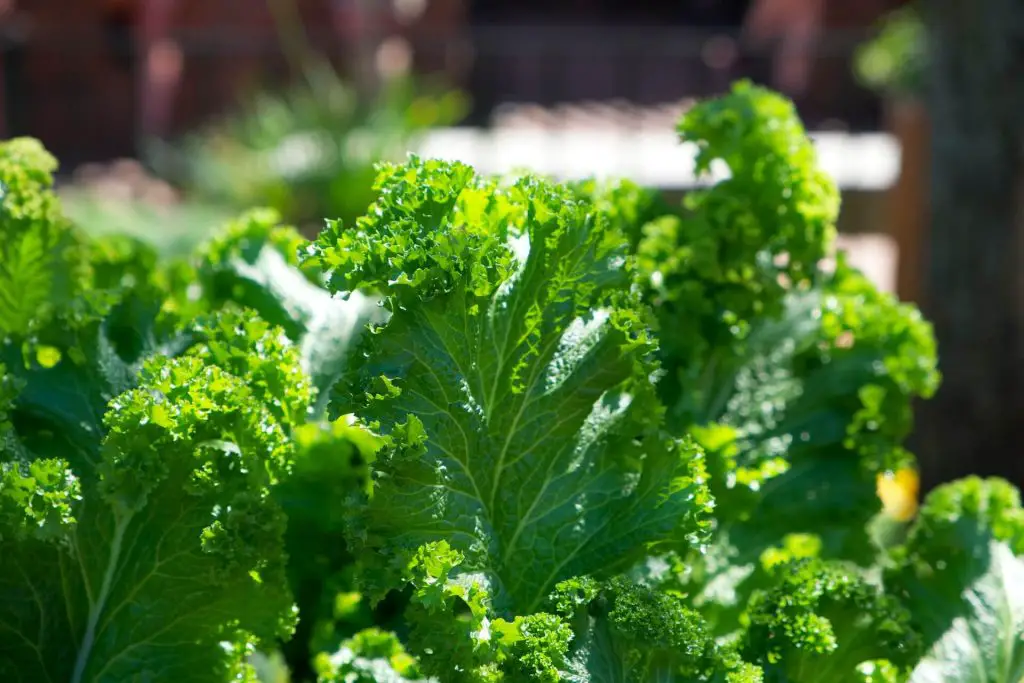
Kale Companion Planting Chart: 17 Types To Consider
I have put together types of kale companions and their benefits in a companion planting chart for a quick overview. You will notice kale companion plants shared mostly helps with pest repelling.
This is because kale is notorious for drawing pests like aphids, loopers, slugs, flea beetles, and cabbageworm. After all, kale is part of the cabbage family.
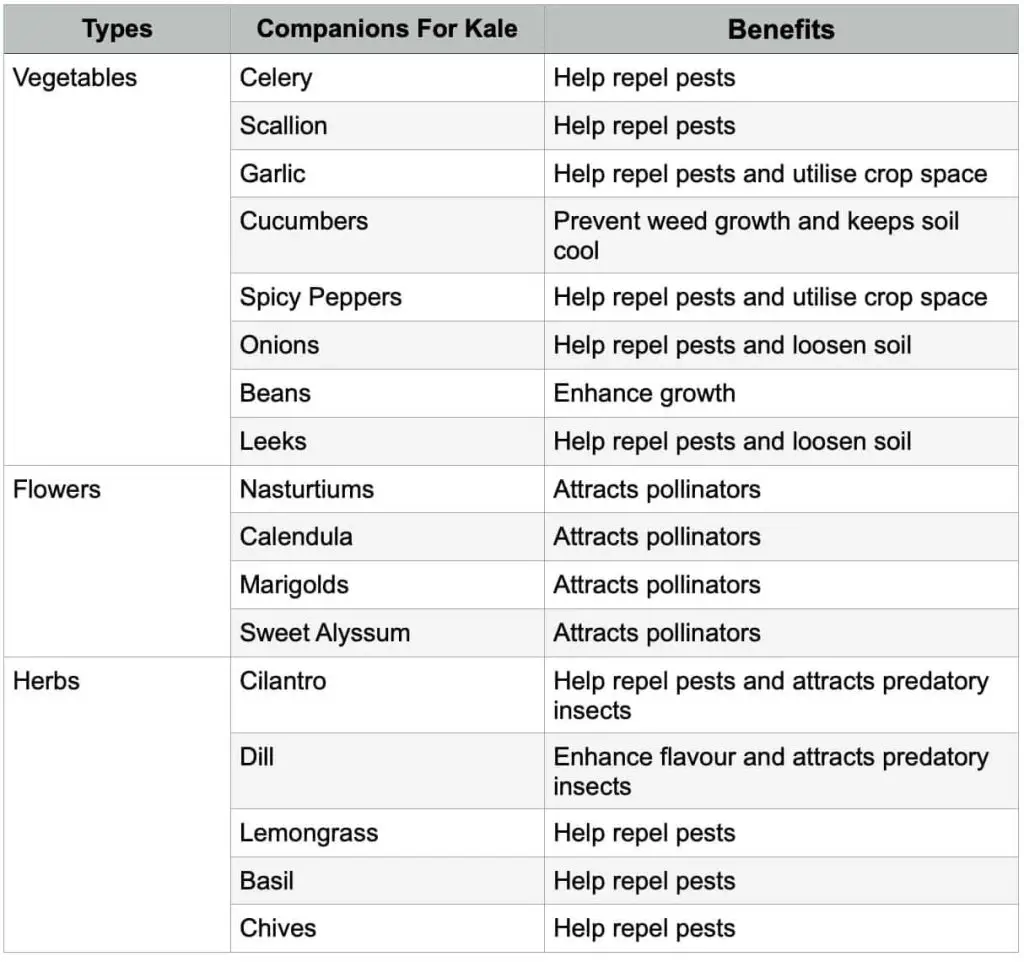
Affiliate Link Disclosure
This post may contain affiliate links, meaning I get a commission if you decide to make a purchase through my links, at no extra cost to you.
Related Posts
- 11 Best Companion Plants For Oregano & What To Avoid! [2023]
- 15 Companion Plants For Cantaloupe & What To Avoid! [2023]
- 13 Best Kale Smoothies For Weight Loss You Have To Try!
Companion Plants For Kale: 17 Types To Consider
8 Types Of Vegetable Companion Planting For Kale
1. Celery
Celery is a great kale companion because it is an organic pest-repellant. Kale draws cabbage worms that infest the underside of leaves and can cause serious damage to your crop.
How does celery help repel pests for kale? The aromatic fragrance of celery leaves helps to repel cabbage worms from eating your kale.
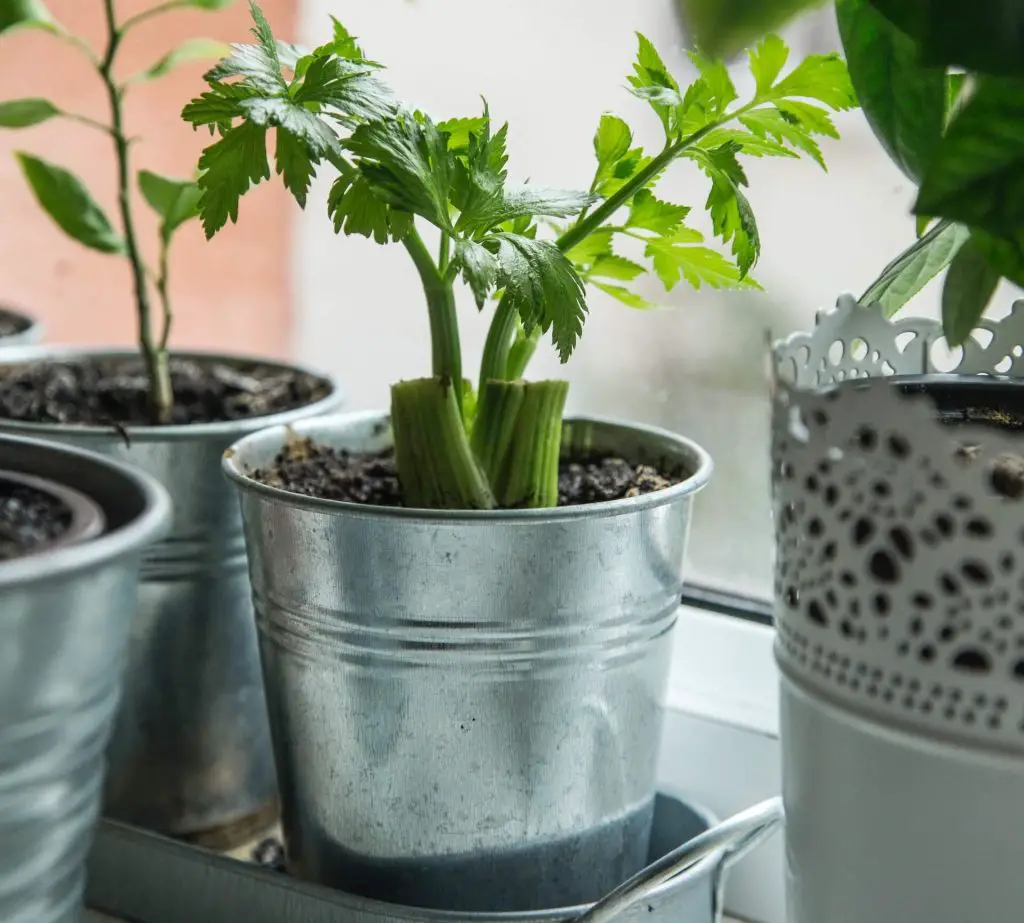
Tips for growing celery are that it takes a longer growing time, around 10 to 12 weeks, and is sensitive to temperature.
It doesn’t tolerate very high temperatures, which is the same for kale. This means you can grow them in the same season as spring or fall crops.
Since temperature is one of the critical success factors, I use Taylor Indoor Outdoor Thermometer to help monitor the weather.
2. Scallion
Scallion is a suitable kale companion because its scent helps to repel a gardener’s nightmare pests such as aphids. Aphids are tiny insects that attack pretty much all parts of the plant. We are talking about leaves, stems, buds, and roots.
They are so hard to detect due to their clear color and size. Often, you will only notice after they have done their damage through your plant. That is why choosing scallion to companion planting with kale is a good preventive measure.
Tips for growing scallion are that compared to celery it grows faster around 8 to 10 weeks, and doesn’t take much soil space. You simply tuck them alongside kale that was just planted and water them regularly. Ensure the soil always to be moist and not dry.
3. Garlic
Garlic is one of the most favored companion plants because it is a natural pest repellent due to its super strong scent. Garlic has the ability to affect many pests such as aphids and moths. Commercially there is also garlic spray as an insecticide.
Even to the human nose, the garlic scent can be unpleasant so we created the term “garlic breath” which describes a person with bad breath.
The sulfuric garlic smell lingers for hours after consumption. This is a great kale companion if you consume garlic in your diet.
Tips for growing garlic are to plant it during fall and it takes around 4 to 8 weeks before ready for harvest. Since garlic grows underground, you can maximize soil space and provide extra protection to your kale.
It is best to plant them during the same season as their growing time and temperature are similar. Additionally, to ensure soil health during winter to prevent freezing, use mulch!
Out of curiosity, I tried garlic spray on my garden and the results were satisfactory. I used the Garlic Barrier 32 oz Insect Repellant White.
4. Cucumbers
Cucumbers are great kale-growing companions because they act as weed suppression due to their vine-like nature. Weed competes with kale for sun, water, and nutrients.
Rather than giving the possibility for weed to grow, choose cucumber to prevent that and get a bountiful harvest in return.
Cucumbers are easy and super fast to grow. It takes only 6 weeks to grow and ripen. It needs consistent watering and sunlight, which helps keep kale soil cool if you’re planting during summer.
One thing you have to look out for is the height of the cucumber so it doesn’t override the kale.

5. Spicy Peppers
There are many types of spicy peppers you can consider as a kale companion. A few well-known types are capsicum, cayenne, jalapeno, serrano, and Thai chili. True to its name, it has a strong scent that comes from capsaicin which repels pests.
Similar to cucumber, spicy peppers prefer direct sunlight and warmth. Therefore, growing them mid-summer before fall starts to ensure the fruit to produce is key.
It takes 6 to 8 weeks before it’s ready for harvest. This way when your kale grows, it already has the pepper’s protection.
6. Onions
Onions have a similar sulfuric scent to garlic, making them suitable for kale companion plants. Another perfect natural pest repellant for kale. They grow underground in bulbous size which aids in loosening the soil.
It is best to grow onions in cool weather during the fall or spring season. It takes around 6 weeks for onions to grow and their bulbs to form.
Please monitor the conditions of the plant like soil moisture and weeds. This is because dryness can cause bulbs to split while weeds can damage their shallow roots.
I use this Walensee Weed Puller to help get the job done effortlessly.
7. Beans
We have covered many pest-repellant kale growing companions. Beans as kale companions help to boost growth through the nutrients they release such as nitrogen.
Additionally, beans are an organic fertilizer that keeps pests such as aphids at bay. Compare to synthetic fertilizer, it attracts more pests.
There are two types of beans: bush beans and pole beans. Both grow well in warmer weather and are recommended to increase in early summer.
Pole beans will need support to climb which helps maximize soil space. Bush beans require less maintenance and have a fast-growing time of 6 weeks.

8. Leeks
Leeks are part of the Allium family, which means cousins to onions and garlic. It can grow up to 2 feet long and 2 inches thick and is the biggest plant within the Allium family.
Even though it is not bulbous like garlic, its size helps loosen the soil, promoting better drainage. This also means leeks share a strong sulfuric scent which is great in repelling aphids and flea beetles that kale tends to attract.
Some tips to grow leeks are to ensure there is enough space 6 inches apart and get 6 hours of sunlight. They grow best in the cool weather of early spring and fall. Take note of their very long growing period of 12 to 21 weeks.

4 Types Of Flowers Companion Planting For Kale
1. Nasturtiums
Flowers like nasturtiums act as a ‘trap crop’ for your kale companion. What is a ‘trap crop’? It is when the plant attracts pests and keeps them full and away from your kale leaves.
Nasturtiums have lily-pad leaves that make aphids, cabbage worms and caterpillars go wild. It is a small sacrifice to keep your kale from being the main dish.
The catch is that there may be an overpopulation of the pests that they move to your kale. That’s why you have to ensure there are predators insects such as ladybugs, praying mantids, and flower flies to control the pests.
2. Calendula
Calendula flowers attract pollinators like bees, hoverflies, lacewings, and ladybugs because of their magnetizing scent. These pollinators are predator insects that feed on aphids, thrips, and nematodes.
Therefore, calendula is another great kale companion that helps to control the pest population. Its flowers are a bright orange-yellow color that instantly beautifies your crop. It blooms in cooler spring weather.
3. Marigolds
Marigolds are my personal favorite flower to companion planting with kale because they are so gorgeous! Of course, besides being aesthetically pleasing to the eyes, marigolds repel aphids and nematodes from kale.
This is because marigolds secrete a chemical that prevents the development of nematode eggs. Nematodes are parasites that live inside plant tissues and cause root, stem, folar, and flower damage if not controlled.
4. Sweet Alyssum
As in the name, sweet alyssum attracts pollinators and predatory insects with its sweet honey scent. By companion planting with kale, these predatory insects help control the pests’ population.
Plus, sweet alyssum doesn’t compete with kale for nutrients and even helps to suppress weed due to its low-growing characteristics.
5 Types Of Herbs Companion Planting For Kale
1. Cilantro
Cilantro is a staple herb in my household and garden. It has a fresh, earthy, and citrusy fragrance that helps repel aphids from kale. Also, it adds a super refreshing flavor garnish to my salsa on taco Tuesdays.
Plant cilantro between rows of kale in spring and harvest it in summer.
2. Dill
Dill is a suitable kale companion herb because its flowers attract lacewings and ladybugs that help control the aphids. I often mix it into yogurt-based dips like tzatziki. It is best to plant near young kale in mid-spring when the weather is warmer.
3. Lemongrass
Lemongrass is a very famous herb that has been commercially bottled into sprays to repel insects and pests. Surely you have noticed reading through this guide that pests hate the strong citrusy scent.
The tip for growing lemongrass is that it needs a lot of soil space because it can grow up to 3 feet wide and in length.
4. Basil
I’m a huge fan of basil as a kale companion plant because it is such a versatile herb to include in cooking. Basil has a strong sweet spicy scent and taste that repels pests. I grow basil near kale in mid-spring in warmer weather and sunlight before the summer heat hits.
5. Chives
Chives are easy to grow herb that takes up very little soil space. It is part of the Allium family and for its size, it is great at deterring pests due to its onion-like smell. This makes chives a wonderful kale companion.
Chives prefer cooler seasons like early spring and fall which requires minimal care. It takes a 6 to 8 weeks growing period before ready to be transplanted next to your kale crop. Critical success factors are moist nutrient soil and mulch.
What Should Not Be Planted Next To Kale?
Companion planting kale with the wrong type of plant will stunt its growth. This is because a bad kale companion plant competes for sunlight, takes nutrients from kale, attracts pests, releases harmful chemicals into the soil, or even prevents kale from germinating.
Below are what not to plant near kale:
- Strawberries
- Tomatoes
- Sunflowers
- Walnuts
- Broccoli
- Cauliflower
- Cabbage
- Brussels sprouts
- Bok Choy
- Collard greens
Tips To Choose Kale Growing Companions
Now that you have a complete understanding of the benefits of companion planting kale, I’m sure you’re eager to get into it. But wait, are there too many options of vegetables, flowers, and herbs to choose from that you can’t decide?
I look at a few factors before deciding. Those few deciding factors are;
- Planting Season
Planting seasons such as fall or spring eliminates what not to plant with kale. Choosing a kale companion that requires the same temperature and sunlight is a low-maintenance way for beginners. For example, kale and scallion as companion plants.
- Soil Size
I then look at the soil size to help decide if I have enough space for the companion plant. For example, if I have a small space, I will opt for an underground vegetable like garlic or weed-suppressing sweet alyssum flowers.
- Growing Period
The growing period is another key factor because each kale companion plants have short (6 weeks) to a long (12 weeks) growing period. In the beginning, I prefer plants that have the same growing period, to reduce planning and care for multiple plants.
As I grew confident in my gardening abilities, I made a seasonal planting plan.
- Planting With Purpose
Lastly, I plant what I want to harvest. Sure each kale companion plants have its specific benefits, but I lean towards choosing a plant that I enjoy eating like basil. Sometimes I just want to beautify my patch and opt for gorgeous marigolds that deter nematodes.
In short, these factors are the process of eliminating kale growing companion types to ensure compatibility, success, and intention.
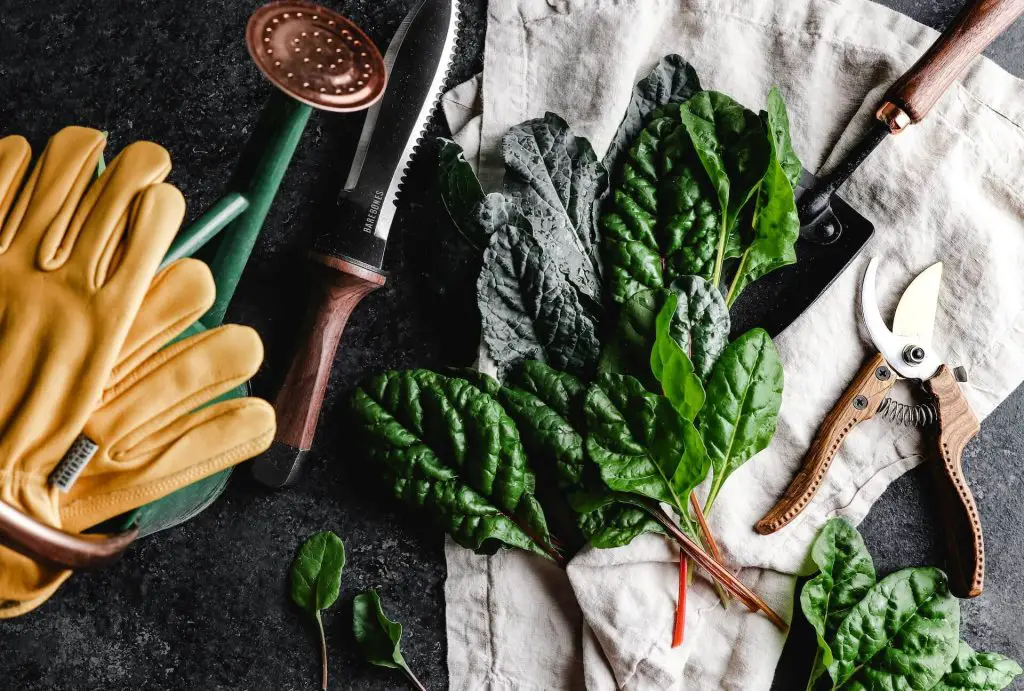
What Are The 3 Reasons To Grow Kale?
1. Kale Is A Superfood With Amazing Health Benefits
Kale is a superfood because it contains highly nutritious vitamins and minerals that are great for our bodies. Some of them are vitamin A for eye and bone health, vitamin C for disease prevention, vitamin K for blood clotting, and vitamin B for brain development.
Plus minerals such as zinc, calcium, and potassium help bones, skin, nails, and hair growth.
2. Kale Is Easy To Grow
Kale is very easy to grow when its basic growing conditions of sufficient water, light, and nutrients are met. For example, kale thrives in cooler spring or fall weather with at least 3 hours of sunlight.
3. Kale Is Easy To Eat
I enjoy cooking kale by sauteeing, steaming, boiling, and baking it with seasoning. Kale can also be eaten raw in nutrient-packed smoothies and salads. Hence, it is so easy to include kale in your diet to help boost your nutrition consumption.
FAQs On Companion Plants For Kale
Do Tomatoes And Kale Grow Well Together
No, tomatoes and kale do not grow well together. Tomatoes are part of the nightshade family which could be a good companion plant for kale. Since tomatoes require more nutrients and can grow up to 4 feet, they might compete with kale for sunlight, nutrients, and soil space. Therefore, it is best not to plant tomatoes and kale together.
What Herb Can Be Planted With Kale?
So, which herb can be planted with kale? Chives can be planted with kale. Chives are easy to grow and take up very little soil space. It is part of the Allium family and for its size great at deterring pests due to its onion-like smell. Chives can withstand various conditions and don’t compete with kale for nutrients.
Are Kale And Onions Companion Plants?
? Yes, kale and onions are companion plants. Onions are the ideal kale companion plant! This includes spring onions or shallots. This is because onions have a strong sulfuric scent that repels pests from kale. Hence, onions deter white cabbage butterflies from laying eggs on kale leaves.
Can Kale And Spinach Be Planted Together?
Yes, kale and spinach can be planted together. Kale and spinach are compatible plants to grow together because they share similar growing conditions. It is best to grow kale and spinach during the cooler season from fall to winter. Additionally, they share the same growing time of 50 to 70 days.
Can I Grow Lettuce And Kale Together?
Yes, you can grow lettuce and kale together. It is great to plant lettuce next to kale because it will not compete for sunlight and nutrients. Plus, kale can help to provide shade for lettuce in warmer weather.
I have shared with you 17 types of companion plants for kale that serve different purposes. You are spoilt for choice here, but I hope not to feel overwhelmed.
Remember, the first step is to determine which purpose aligns with your needs. Once you have that, narrow down your choices and get to planting! It’s a no-brainer how many benefits you will gain from companion planting.
Just think about the abundance of food you can get and turn into delicious, healthy, and sustainable meals as I shared. Consequently, it’s a great way to save money.
If you have experience using the companion planting method, do share it with me. This is to encourage our community of growers further. Happy planting!
Related posts




![When To Harvest Jalapeños? [+Mistakes To Avoid]](https://aboveandbeyondgardening.com/wp-content/uploads/2021/10/When-To-Harvest-Jalapenos-768x512.jpg)
![Why Are The Leaves On My Plant Curling?[And How To Fix It!]](https://aboveandbeyondgardening.com/wp-content/uploads/2021/10/Why-are-the-leaves-on-my-plant-curling-768x502.jpg)

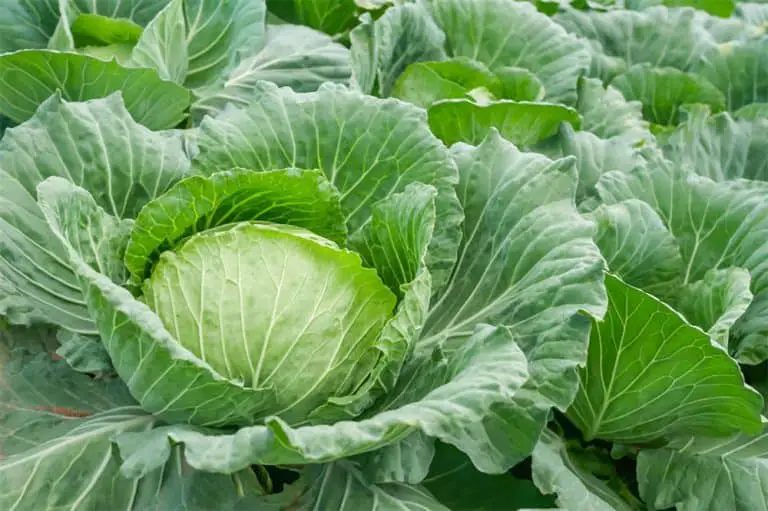
![15 Companion Plants For Asparagus To Help It THRIVE! [2023]](https://aboveandbeyondgardening.com/wp-content/uploads/2022/11/companion-plants-for-asparagus-768x510.jpg)
![How To Harvest Swiss Chard Without Killing The Plant [Exact Steps!]](https://aboveandbeyondgardening.com/wp-content/uploads/2022/10/how-to-harvest-swiss-chard-without-killing-the-plant-768x512.jpg)